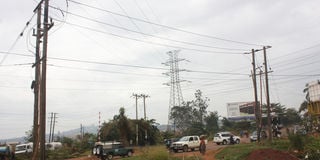Prime
Counting the cost of missing evacuation lines

Motorists drive past power transmission and distribution lines on Old Port Bell Road in Kampala.
Some agreements between the generation and transmission company provide for capacity charge whereby regardless of the amount of power taken, you must pay a fixed amount of money. But sometimes you don’t get the power . PHOTO/file
What you need to know:
Evacuating power. Whereas transmission evacuation lines carry high voltage power, distribution lines cannot, which not only results in energy losses but also limited evacuation of power.
The frustration in Gulu city over electricity outages is written all over the residents’ faces.
“It flickers like a disco light,” a resident describes the state of power outages in Gulu. Businesses, on the other hand, have lost a lot of money by hiring power generators.
Cynibel, a retail supermarket chain store, says they can go without power for three days, which translates to fuel costs for the business incurred through using generators.
Mr Robert Otim, founder of Opit investments, a milling industry is eying the nascent South Sudan market as well as the local community but the challenge of limited capacity of the transformer dedicated to the industry will not let him realise the demand.
Plagued by bush burning, vandalism, old and dilapidated lines, power outages in Gulu keep recurring. For years, the northern town has decried power outages and a solution has been promised.
The ray of hope faded for some, but a drowning man will clutch at a straw. Commissioned at the end of 2019, the 42 Megawatt (MW) Acwa dam was expected to be the saving grace.
Issues of power outages were to be a thing of the past, different stakeholders in the power sector promised.
Flash-forward to the tail end of 2020, Gulu, now with city status, still sings the power outages chorus.
What happened to Acwa?
A few months left to commissioning of the dam, there was no evacuation line in site. Uganda Electricity Transmission Company Limited (UETCL), the government company in charge of evacuating high voltage power from dams in Uganda and later sells to power distributors had at the time, only just acquired the engineering, procurement and construction contractor of a 132 kilovott(Kv) power evacuation line.
Since the country had run out of time and heightened the risk of incurring capacity payments for the power the dam would have potentially been producing, an interim solution was created.
Uganda Electricity Distribution Company Limited (UEDCL), with Shs30b from government, built a 33kv distribution evacuation line that would supply only 12MW of the 42MW installed capacity of the dam.
Temporary solution
This solution was short-lived.
A recent trip to the northern region revealed that the dam even with the interim solution was not producing power.
According to Mr Jonan Kiiza, the spokesperson of UEDCL, the power line distributed power for close to four months but could not proceed due to trips on the system provoked by differences in design of the dam and line.
“The 33Kv double circuit line evacuated power from January 18 to April 2 2020. The infrastructure which was put in place by UEDCL at Acwa was designed based on island mode. At the time of commissioning, the developer indicated that island mode can only be possible if the network loads are switched in loads of 1 megawatt at a time,” he explained.
Island mode is a state in which a hydro power plant operates in isolation from the national grid.
Power ordinarily moves from the dam to a transmission substation and it is from there that distributors pick power to supply households.
In island mode, there is no transmission network (national grid). Power from the dam is supplied directly through the distributors.
However, when discussed with Umeme and UETCL, Mr Kiiza says, the companies indicated that their network design at the moment, does not allow for load stepping.
“The option we had was to synchronise with the national grid. However, the grid was unstable and frequently tripping thus causing instability in power supply in the region. Thereafter, we experienced a voltage transformer (VT) failure which has since hindered continuation of power generation,” he adds.
Consequently, UEDCL upon receiving guidance from Ministry of Energy started revamping the Gulu- Lira and Gulu Kitgum Lines respectively to boost reliability of the power supply. The works are expected to be completed in December.
On the dam, Mr Kiiza says their concessionaire; Umeme is exploring the island mode to find a lasting technical solution.
However, the scenario of Acwa dam is not an isolated incident. There are other dams that are constructed in the absence of transmission evacuation lines.
For instance, Siti 2 and Nkusi dam along Lake Albert and Kikagati dam in Isingiro. Similar to Acwa, a distribution line was constructed to evacuate power because of the absence of transmission power lines.
Challenges
Whereas transmission evacuation lines carry high voltage power, distribution lines cannot, which not only results in energy losses but also limited evacuation of power.
For instance, UEDCL evacuates only 12MW from a 42MW Acwa dam which means that subject to the power purchase agreement government has with a power producer, the public would have to incur capacity payments, in other words capacity of electricity a dam could potentially produce for supply.
Some agreements between the generation and transmission companies provide that you pay for the power received from the generation company. Other agreements provide for capacity charge. This means regardless of the amount of power you take, you must pay a fixed amount of money. But sometimes you don’t get the power yet you must pay the fixed amount.
In addition, the UEDCL report highlighted that the company owes UETCL more than Shs5b which are due to evacuation losses encountered on the Siti and Nkusi mini hydros.
“The major cause of the energy losses is due to the evacuation of high voltage power onto low and medium voltage distribution lines which results into significant energy losses … with losses of 31 per cent, 37 per cent and 47 per cent,” the auditor general Mr John Muwanga notes in his report about the company’s 2018/19 performance.
Mr Paul Mwesigwa, managing director UEDCL, says since they started evacuating power from dams in June 2018, the company has registered 14 per cent in evacuation losses which is equivalent to Shs14b.
About Shs1b on a monthly basis for three dams.
UEDCL in consultation with the power regulator, Electricity Regulatory Authority (ERA), says they have developed modalities around which issues of evacuation losses are resolved.
“The evacuation losses that are generated by the mini grids are not a UEDCL cost because it is a transmission activity, they should be catered for under their expenses,” he says.
This means the Shs14b would be incurred by UETCL which is also a wholly government owned company signifying that the cost would revert back to taxpayers.
UETCL financing challenges
To cast a rock at UETCL would partly be a misjudgment. The transmission segment in the electricity sub-sector is capital intensive, requiring trillions of shillings to build transmission lines around the country.
According to the regulator, there is a $5.1 billion requirement to support the infrastructure required to evacuate the power.
“Out of the total investment, $1.6billion is required for power evacuation, while $2.07b is required for network expansion. Regional interconnection requires $700 million,” Ms Ziria Tibalwa Waako, chief executive officer ERA says.
Key to note, of the $5.1b required, only $2.5b is committed to finance these needs between 2020 and 2025, while $2.6 billion remains unfunded.
That is why the regulator is creating a framework to allow private sector investment into the transmission segment, a move expected to rally the required investment.




